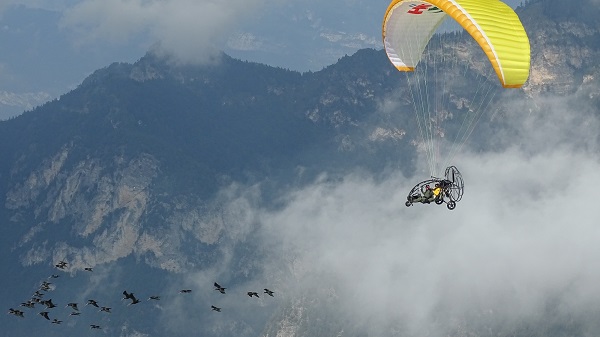Record flights towards south
Newsletter 19/07/2019
On August 14th at 9:15 am, two microlight aircrafts took off from Heiligenberg; they were piloted by Walter Holzmüller and Johannes Fritz and had the two foster mothers Helena Wehner and Anne-Gabriela Schmalstieg aboard. It was the beginning of the 14th human-led migration in the context of the reintroduction of the Northern Bald Ibis in Europe. During the previous weeks, thirty birds were trained to follow the microlight aircrafts.
The departure was witnessed by around 120 people. It was the final highlight of an outstandingly successful season, also with regard to the project’s public relations. A total of around 1,700 visitors have been coming to Heiligenberg since the beginning of June to see these charismatic birds and to find out more about the LIFE project. On 27 days during the past season, filming took place for 13 television productions and a 360° production. In addition, the project was presented in early August in the ZDF talk show with Markus Lanz with nearly 1.7 million viewers.
The first flight led over 91 km to Schnepfau in the Bregenzerwald. Supporting wind accelerated the flight so that the formation reached the destination after 01:45 hours.
After a day of rest we continued our journey, tackling the king stage over the Arlberg and Reschenpass to Schluderns in the Italian Vinschgau on the 16th of August. Several records were broken during this flight: We reached an altitude of up to 2,900 meters and thus flew nearly 300 meters higher than ever before in this project. In addition, assisting winds facilitated our progress, so that we reached a very high average speed of 57 km/h and covered the distance of 126 km in just 02:13 hours. And finally, we crossed the Austrian-Italian border earlier in the year than ever before.
Although it is not the goal of the project to deliver peak performances, the ever-new records show the great potential of the human-led migration as a conservation method and are impressive testimony to the performance of the Northern Bald Ibises.
All birds are equipped with miniaturized measuring devices during the flights. Thus, the position, the wing beat frequency and the flight speed of each bird are recorded in high frequency and resolution. Four birds are additionally equipped with adhesive electrodes to measure the heart rate. This data will be evaluated by two PhD students within the framework of an Austrian research project and will provide new and detailed insights into the function and energetics of the formation flight in migratory birds.
Meanwhile, we have reached the Po Valley and are currently staying at the airfield in Thiene. The flight over was also very good, apart from another attack by a golden eagle shortly before Thiene. Luckily, all birds emerged from the attack unscathed. There are still three stages left before we reach the wintering area in southern Tuscany.
Picture (AG Schmalstieg): Above the clouds, on the way to Thiene.
Click here to get to our Newsletter archive.





